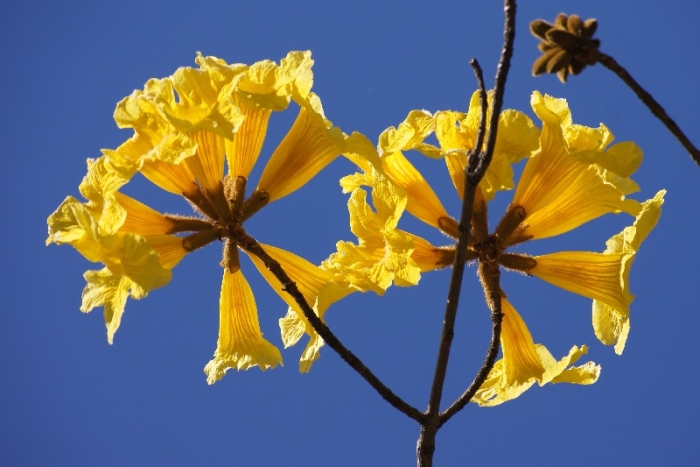Guayacan
(Handroanthus guayacan)
Guayacan (Handroanthus guayacan)
/
/

Tatters
CC BY-SA 2.0
Image By:
Tatters
Recorded By:
Copyright:
CC BY-SA 2.0
Copyright Notice:
Photo by: Tatters | License Type: CC BY-SA 2.0 | License URL: https://creativecommons.org/licenses/by/2.0/ | Uploader: Tatters | Publisher: Flickr |





























Estimated Native Range
Summary
Handroanthus guayacan, commonly known as Guayacan, is a deciduous tree native to dry forests, savannas, and other open areas in Central America, Colombia, Ecuador, Peru, and Venezuela. It can reach heights of 60-100 feet (18-30 meters) with a canopy spread of 35-50 feet (11-15 meters). The Guayacan has a straight trunk with a high, dense crown and a gray, furrowed bark. It is renowned for its large, showy, bright yellow flowers that bloom in clusters, primarily in the spring and early summer, creating a stunning display. After flowering, it produces woody seed capsules.
Guayacan is valued for its ornamental beauty, particularly the vibrant floral display that attracts pollinators such as bees and butterflies. It is used in tropical and subtropical landscapes, including urban settings, for shade and as a specimen tree. This species is drought-tolerant once established and prefers well-drained soils, though it can adapt to various soil types. It requires full sun for optimal growth and flowering. While it is not known for significant pest or disease issues, it can be susceptible to root rot in poorly drained soils. Guayacan wood is extremely hard and durable, making it useful for heavy construction, such as in shipbuilding and tool handles.CC BY-SA 4.0
Guayacan is valued for its ornamental beauty, particularly the vibrant floral display that attracts pollinators such as bees and butterflies. It is used in tropical and subtropical landscapes, including urban settings, for shade and as a specimen tree. This species is drought-tolerant once established and prefers well-drained soils, though it can adapt to various soil types. It requires full sun for optimal growth and flowering. While it is not known for significant pest or disease issues, it can be susceptible to root rot in poorly drained soils. Guayacan wood is extremely hard and durable, making it useful for heavy construction, such as in shipbuilding and tool handles.CC BY-SA 4.0
Plant Description
- Plant Type: Tree
- Height: 60-100 feet
- Width: 35-50 feet
- Growth Rate: Moderate
- Flower Color: Yellow
- Flowering Season: Spring, Summer
- Leaf Retention: Deciduous
Growth Requirements
- Sun: Full Sun
- Water: Medium
- Drainage: Slow, Medium, Fast
Common Uses
Bee Garden, Bird Garden, Butterfly Garden, Hummingbird Garden, Low Maintenance, Showy Flowers
Natural Habitat
Dry forests, savannas, and other open areas in Central America, Colombia, Ecuador, Peru, and Venezuela
Other Names
Common Names: Guayacán
Scientific Names: , Handroanthus guayacan, Tabebuia guayacan, Tecoma guayacan,
GBIF Accepted Name: Handroanthus guayacan (Seem.) S.O.Grose